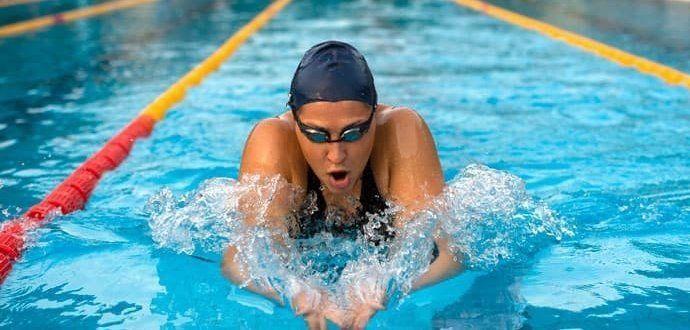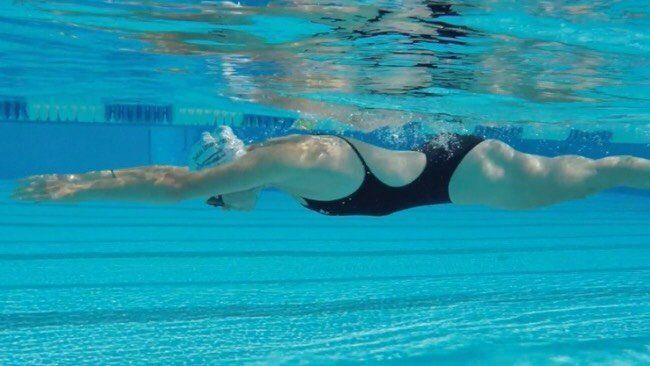
Swimming: Improving Technique
A few tips to help you improve your breaststroke technique and make the most of your time in the pool.
In the water
- Make sure your body is in a straight position in relation to your head and face facing forward.
- Keep your shoulders, hips and legs in a horizontal position but give the body a slight incline, to allow kicking of the legs underwater.
- Legs use their core and abdominal muscles to kick properly, so it's important not to let the hips drop into the water. The legs should be behind and not under our body.
- Keep the neck and shoulders as relaxed as possible to help move the arms and reduce stress. Look down as you slide to avoid neck strain.

The movement of the hands
- Hands glide through the water and move down and out.
- Keep your shoulders up and move your arms out in a circular motion.
- The arms should then be brought together towards the body with the elbows slightly raised, as if they were to meet at the upper part of the chest. Like you want to collect a big ball of water in your arms.
- Don't spread your arms too far, don't let your hands and your opening slip out. Remember the push comes from the legs, not the arms
- Your hands can return to their original position above or below the water. Your shoulders can stay below the surface, but they can also be slightly out of the water.
- The final phase of the hands is to stretch in front of the head and approaching each other holding them for 1-2 times without rushing to resume their movement. It is the phase where arms and legs are simultaneously in a straight line, letting the body slide in the water.
The continuous pull brakes the body in the water not letting it slide..!
Kick
- Unlike freestyle swimming, most of the propulsion comes from kicking the legs.
- The knees should be slightly apart, just above hip length, pointing down, slightly behind the thigh line.
- Point the feet outward as they sweep the water in a circular motion. Try to have stretch but not loose. Make a small circular motion with the initial purpose of pushing the water. It is exactly the movement that a frog makes in the water.
- The legs complete this movement, long and aligned.
- Try to bring your feet to the top of your thighs and not your knees to your chest.
The apron, the push we mentioned, must be done a little below the surface of the water and not above.
The water molecules at the surface are more dilute in contrast to those lower down. Therefore the further down the final apron goes in the push, the more effective it will be. Higher we don't feel a push, slightly deeper you will see the difference...!
Synchronization
- Good timing between the movement of the arms and legs is necessary to get the best result.
- Try to adjust your arm movement and leg kick so that there is always something to propel your body through the water.
Swimming: Improving Technique
Breathing
- Shrug your shoulders to bring your face out of the water to breathe. Don't raise your head.
- Let the shoulders act as a base of support so that your jaw is just above the water.
- Lifting the head and not the shoulders in the first phase can lead to straining the neck muscles, consequently lowering the hips and thus increasing the resistance
- Inhale through the mouth before letting your shoulders drop as you move your arms. Exhalation usually occurs with tension during the glide.
Turn
- The hands should touch the wall simultaneously below, above or right on the surface of the water.
- Rotate your body with your knees tucked into your chest and your feet seeming to go into the wall.
- Move the arm that is higher above your head and push through the water as if you were bouncing off the wall.
- Bring your body into a hydrodynamic position, parallel to the water so that your jaw and chest form a continuation of your extended legs.
Taking the "power" of the wall push, hold your hydrodynamic position for at least three times or when you feel that you are "losing" your time...! - At that time give a strong push with the hands with a strong pull (under water always), spread hands, gather, stretch to the height of the thighs, also stay three times keeping your hydrodynamic position and your fora.
- Then keep your hands under the body, "unfold" the arms in the same way but opposite to the front of the head. At the same time kick hard to get the last stage of the turn with outstretched arms and legs..
- As you raise your head begin the normal arm movement with the head entering the surface of the water before the hands.
Saltamanikas Nikolas
TEFAA graduate, Swimming specialty
Class A swimming coach
Swimming: Improving Technique

No Comments